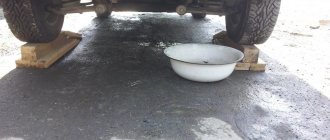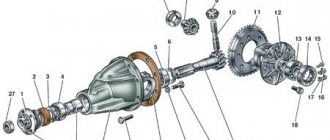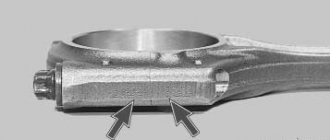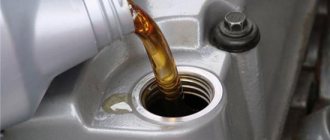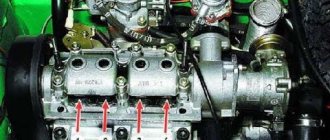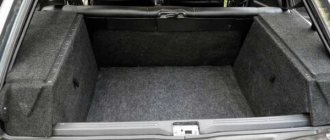Eye machines have a mixed reputation. But one cannot deny the fact that these domestically produced cars continue to be actively used in many cities and countries. Depending on the engine type, cars are referred to as VAZ-1111 or VAZ-11113. There is no fundamental difference between them. It’s just that version 11113 is equipped with a more powerful motor. The Oka is a compact city car with a small engine in volume and power. This makes the car very economical. AvtoVAZ, which produced these cars, created the simplest possible design. Due to this, owners are able to independently carry out maintenance, change basic consumables and even carry out minor repairs. When choosing motor oils for Oka engines 11113 and 1111, you should proceed from the official recommendations of the automaker. The procedure for replacing the lubricant itself is simple, which allows you to do it yourself in a short period of time. If you follow all the rules and recommendations, no problems will arise during the work.
When choosing engine oil for replacement, you need to focus on the manufacturer’s recommendations.
History of VAZ 1111/11113 engines
The engineers who developed the Oka car faced a rather difficult task - to make a compact and affordable vehicle, made from common components and with good maintainability. Similar requirements were put forward for the engine - it had to be simple, reliable and easy to repair in the event of a breakdown outside specialized service stations with qualified personnel.
In the first versions of the Oka, the developers used a two-cylinder power unit from Daihatsu Quore with 30 horsepower. Several prototypes were made with this engine. But, although the engine had a well-functioning and reliable design, they refused to copy it, since the foreign power unit required high quality engine parts and assembly standards. In addition, copying required assembling engines from scratch and mastering the corresponding technical process, and this would make the car unacceptably expensive and seriously delay the production of serial samples.
Then the engineers turned to existing engine solutions in the domestic auto industry.
Interesting: the choice of engine was influenced by the launch of the VAZ-2108 on the assembly line of the Togliatti plant.
The G8 engine was already fully developed, so to equip the new compact youth car, it was decided to create a two-cylinder engine based on the G8 engine, which at that time was the main one in VAZ production. Through a series of technical manipulations, the 1111 engine was obtained, which they began to equip the Oka with.
VAZ 1111 engine - features and design
The 650 cc engine 1111 is “half” of the 2108 engine. To create it, they simply took half of the engine and cylinder block, since it was easier and cheaper to develop equipment for such a solution than for a new unit. Thus, the 1111th is a two-cylinder in-line petrol carburetor engine, with 2 valves per cylinder and an overhead camshaft configuration.
1111 assembled:
Main characteristics of the Oka engine:
- power - 30 forces;
- volume – 649 cubic meters. cm.;
- torque - maximum 44 Nm at 3400 rpm;
- recommended fuel is gasoline with an octane rating of 92;
- cylinders: 2;
- type of food – carburetor;
- valves – 4;
- fuel consumption – about 4.7 liters per 100 km;
- engine cooling – liquid;
- engine environmental standard: Euro-0.
Weight and dimensions of the Oka engine:
- weight – 66.5 kg without gearbox and clutch;
- overall dimensions – 550*640*670 mm.
The entire working process takes place in two revolutions of the crankshaft, due to which the engine experiences severe vibration loads. To compensate for them, two balancing shafts are provided to reduce motor vibration.
Interesting: in the VAZ 1111 engine, the fuel pump is not electric, but mechanically driven from the engine.
The supply of the fuel mixture is controlled by the carburetor. The lubrication system, as in 2108, is created with the installation of a gear pump. Engine oil is taken from the crankcase and supplied to the friction pairs of the camshaft and crankshaft. The cylinders are irrigated with oil mist generated during the operation of the crankshaft, and the engine gas distribution mechanism and valve rods are lubricated by gravity.
Replacing engine oil and oil filter VAZ "OKA" 1111 1988-2008
- Repair manuals
- VAZ "OKA" 1111 1988-2008
- Changing the engine oil and oil filter
You will need: a 17mm wrench, a screwdriver, a container for draining oil, engine oil, a special wrench for removing the oil filter. This is where the oil filter is located on the engine.
Drain the oil after driving while the engine is still warm. If the engine is cold, start it and warm it up to operating temperature.
Fill with the same brand of oil that was in the engine. If you nevertheless decide to change the brand of oil, then flush the lubrication system with flushing oil or oil of the brand that will be used. To do this, after draining the old oil, fill in new oil to the lower mark of the oil level indicator. Start the engine and let it idle for 10 minutes. Drain the oil and only then change the oil filter. Now you can fill in new oil to the required level (top mark on the dipstick)
| Equipment name | Basic 11113 |
| Release period | 1996 — 2006 |
| type of drive | Front |
| Body type | Hatchback |
| Transmission type | Manual transmission 4 |
| Engine capacity, cc | 749 |
| Body brand | 1111 |
| Acceleration time to 100 km/h, seconds | 24 |
| Maximum speed, km/h | 135 |
| Ground clearance (ride height), mm | 150 |
| Number of doors | 3 |
| Steering wheel position | left |
Dimensions | |
| Body dimensions | |
| Body dimensions (L x W x H), mm | 3200 x 1420 x 1400 |
| Interior dimensions | |
| Number of places | 4 |
| Number of seat rows | 2 |
Characteristics of the car chassis | |
| Wheelbase, mm | 2180 |
| Minimum turning radius, m | 4.6 |
| Front track width, mm | 1210 |
| Rear track width, mm | 1200 |
Weight and permissible loads | |
| Weight, kg | 645 |
| Permissible total weight, kg | 985 |
Volumes | |
| Fuel tank volume, l | 30 |
| Trunk volume, l | 210 (630) |
Engine, gearbox and steering | |
| ICE | |
| Engine make | VAZ-11113 |
| Maximum power, hp (kW) at rpm | 33 (24) / 5600 |
| Maximum torque, N*m (kg*m) at rpm. | 50 (5) / 3200 |
| engine's type | In-line, 2-cylinder |
| Add. engine information | Carburetor, overhead valve timing system with overhead camshaft |
| Type of fuel | Gasoline AI-92 |
| Cylinder diameter, mm | 82 |
| Piston stroke length, mm | 71 |
| Turbine | — |
| Number of valves per cylinder | 2 |
| Specific power, kg/hp | 19.55 |
Fuel consumption | |
| Fuel consumption in the city, l/100 km | 7.4 |
| Fuel consumption outside the city, l/100 km | 5 |
| Fuel consumption in mixed mode, l/100 km | 6,8 |
Steering | |
| Steering type | Rack and pinion |
Suspension / Chassis | |
| Suspension | |
| Front stabilizer | |
| Front suspension | Independent, MacPherson-type shock-absorbing strut |
| Rear suspension | Semi-independent, torsion beam |
Discs | |
| Tire size | 135/80 R12 Reviews of tires 135/80 R12 Buy tires 135/80 R12 |
Brakes | |
| Front brakes | Disk |
| Rear brakes | Drums |
Internal equipment | |
| Add. interior equipment | |
| Cooled glove box | — |
Active and passive safety systems | |
| Electronic safety and traffic control systems | |
| Anti-lock braking system (ABS) | — |
Driver kit | |
| Full size spare wheel | |
| WARNING Do not dump used oil on the ground. |
| 1. Turn the oil filler cap approximately 90° counterclockwise and remove it. | 2. Remove the plug from the drain hole in the engine oil pan, first placing a container under it, and drain the used oil. |
| 3. Screw on the plug. |
| WARNING Oil is hot - be careful. |
| 4. Unscrew the oil filter and remove it. |
| USEFUL TIPS Use a special wrench to unscrew the oil filter. If there is no such key or similar puller, pierce the filter housing with a screwdriver and, using it as a lever, unscrew the filter, punching the filter as close to the bottom as possible so as not to damage the fitting. You can also use a double-folded strip of coarse sandpaper, wrap it around the filter and push it out of place with your hands. |
| 5. Fill the internal cavity of the new filter with clean engine oil to about a third of the volume (to reduce the engine operating time during the first start-up under “oil starvation” conditions). |
| 6. Lubricate the O-ring of the new filter with clean engine oil and screw the filter into place by hand without using tools. |
| 7. Fill in clean oil (see subsection “Checking the level and adding oil to the lubrication system”). Close the oil filler cap. |
| 8. Start the engine and let it idle for several minutes (the low oil pressure warning light should go out 2-3 seconds after starting the engine). While the engine is running, check for oil leaks from under the drain plug. Stop the engine, check the oil level and, if necessary, add to the required level. |
Motor VAZ 11113
This engine appeared later as a modification of the same engine from the V8, when the latter was brought to a volume of 1.5 liters (VAZ-21083). The engine was again “halved”, resulting in a 750 cc unit. The appearance of motors 1111 and 11113 is the same, the changes affected only the internal part. The car with this engine was called LADA OKA.
So, it was increased to 81 mm. motor piston diameter (from 76). Engineers installed an additional cooling system for the combustion chamber and made the inter-cylinder partitions thicker.
Additional cooling turned out to be necessary due to the increased heat generation of the new engine: without it, the pistons often jammed, the cylinder walls lifted, and other malfunctions occurred, typical of engine overheating.
The updated engine became 3-5 horsepower more powerful, although it remained carburetor-powered. Otherwise, the VAZ 11113 engine received technical characteristics almost no different from its “younger brother”, in particular, the eco-standard remained Euro-0, and the design of the fuel supply system (carburetor) remained the same. Main parameters:
- working volume – 749 cubic meters;
- power developed by the motor: 33 forces;
- standard torque: 50 Nm at 3200 rpm;
- fuel: 92 gasoline:
- fuel consumption: up to 6.2 l. by "hundred".
Interesting: Oka received the 11113 injection two-cylinder engine, such a project existed at the plant, and in 2005 a limited number of these cars were even produced. The injection version received the marking 11113-20. But the new product did not go into wide production due to many problems and the need for improvements, although today you can still buy a kit to convert the engine into an injection one.
This is what the factory injector kit looks like for the 11113th engine:
Other Oka engine models
After AvtoVAZ practically curtailed its minicar production, the remaining ones attempted to install other engines:
- previously reviewed 11116;
- Korean Hyundai Atos unit (did not go into production);
- MeMZ 245 (went into small-scale production);
- MeMZ motor model 247.1 (can be found very rarely).
Created on the Oka platform, the all-terrain vehicle on tracks is equipped with a unit from the VAZ 2131, and the forced sports version is powered by engines from the Lada Priora.
Basic faults
In the early days of the 1111/11113's existence, Oka owners often complained about increased annoying vibration and noise from the engine compartment. The noise was especially loud when the engine was warming up; the balancer shafts mentioned above were to blame for it. This phenomenon worries car owners, but is not considered a malfunction. The engine may also be noisy due to too large valve clearances. The problem is eliminated by adjusting them. Vibration is a design feature, since the engine only has two pistons. A fairly common problem with engines is burnout of the cylinder head gasket. Its main reasons:
- factory production flaws, when the gasket was manufactured with inaccuracies;
- Incorrect tightening of the cylinder head, in which the gasket is not fully compressed.
If the motor is repaired, the seal is replaced and cannot be reused.
Important: if there are burrs on the new gasket, it is also not recommended to install it in the engine.
The Oka 11113 engine may have difficulty starting “hot” after a short stop. The reason for this is the layout of the engine compartment and problems with the fuel pump diaphragm. In a hot VAZ 11113 engine, fuel vapors are formed, including in the cavities of the fuel pump, and this unit is not intended for pumping gases and can “fail” when starting the engine before it cools down. The aperture can be changed.
Important: if a problem with the motor occurs on the road, you can simply place a damp cloth on the pump as a temporary measure. This will cool the unit somewhat and allow you to get to the place where the diaphragm can be replaced.
Other possible problems:
The ignition coils are located in such a way that water can enter them, for example, when the car crosses puddles. Water causes the voltage booster module to fail, and as a result, the engine cannot be started. There may also be general wiring problems associated with poor build quality and poor-quality wires, which are typical for VAZ engines in general.
- Damage to the engine cooling system.
Most often the pump fails due to poor assembly and low quality components. If the pump fails, the engine overheats and breaks down, so you need to monitor the temperature of the unit and change the pump promptly, if necessary. The engine thermostat is also not of high quality and may fail, with subsequent replacement.
- Electronic sensor failures.
Oka engines use domestically assembled electronics, which are not of the best quality, and sensor failures are not uncommon. In addition, they are not always properly secured to the unit body due to poor production standards.
Despite these problems, many repair operations, with the exception of complex specific breakdowns, can be performed by the car owner independently or in a “garage” car service. Spare parts from motors 21083, 21093 are suitable for repairs.
Replacement frequency
The frequency of oil changes in the VAZ 11113 Oka engine is 6 months, or 10,000 km. These are the numbers indicated by the manufacturer in the vehicle’s operating manual. But the duration of use of the lubricant is affected by the operating conditions of the vehicle.
Factors affecting the frequency of engine lubricant replacement:
- exposure to low temperature;
- frequent idling;
- driving in rural areas on dusty roads.
If one or more of these factors is influenced, the engine lubricant will have to be changed earlier than the specified period.
Using the step-by-step instructions provided, VAZ 11113 Oka owners will be able to easily change the engine oil in their cars.
Maintenance
The declared resource of Oka engines under conditions of timely and correct maintenance is 120 thousand km. That is, these units, despite a number of inherent problems, can be called relatively reliable in their category.
The scheduled maintenance period is every 15 thousand kilometers. As part of the service, the oil is changed (it is advisable to use a synthetic lubricant; if semi-synthetics were poured into the engine, the interval is reduced to 10 thousand km). Therefore, when choosing which oil to pour into the Oka engine and when, you should clarify what liquid is already in the crankcase. When replacing, the oil system is washed and the oil filter is changed. Oil viscosity grade – 0W 40. 5W 40, 10W 40, depending on the season.
The lubricant volume in the 1111/11113 engine is 2.5 liters, the level is controlled by the oil dipstick. Overfilling liquid is strictly prohibited!
Valve clearance adjustment is supposed to be done every 30 thousand, but in fact it is carried out according to necessity and the actual condition of the engine. Also at this mileage you should clean the carburetor and adjust the idle speed.
After 60 thousand mileage, the fluid in the cooling circuit should be changed. If this is not done on time, the substance will degrade and lose its anti-corrosion and lubricating properties, reducing the life of the system as a whole. At this mileage, it is strictly necessary to replace a worn timing belt: if it breaks, the valves will bend, which will lead to the need to change the engine or make expensive repairs.
Replacement with flushing
The replacement sequence is described above if the same oil is poured into the engine as was previously used.
But some owners, for various reasons, have to switch to another brand of lubricant. And in this case, it is recommended to carry out the replacement with pre-washing. This operation is simply a two-stage lubricant change.
Its essence is this: after draining the lubricant, fill the engine with flushing liquid (but preferably with oil that will be filled) and change the filter. Next, we start the power unit, give it time to run (15-20 minutes), drain everything and pour new lubricant into the motor, and also change the filter element.
Therefore, if you plan a shift with flushing, you should stock up on double the amount of oil (5 l) and two filters. In this case, you can take the cheapest one filter, since it will only work for 20 minutes.
- daily maintenance;
- maintenance every 25-30 hours of operation;
- maintenance every 50 hours of operation;
- change the transmission oil every 100 hours of operation;
- maintenance during storage
Engine maintenance is carried out in accordance with the requirements of the engine operating manual.
Tuning the Oka engine
Since the power of the power unit is small, tuning as such does not make much sense: you can achieve an increase of up to 10%, especially with flashing the ECU of the injection version of the engine, but against the general background it will not be noticeable. The technical characteristics of Oka engines do not allow them to extract much power.
As a “custom project”, the owners of these cars can install an injector from a VAZ-21083i engine with improved characteristics, but this is a rather labor-intensive and financially expensive operation. In terms of cost, it is approximately equivalent to installing the Chinese TJ376QE mentioned above. To continue tuning and extract more power, a compressor can be installed on an injection engine and other modifications can be made as desired.
Some drivers are interested in how much oil to pour into the Oka. This is, to a greater extent, a question that worries those who use the VAZ-1111 car and other modifications of it. Or those whose loved ones (for example, someone from the older generation) purchased such a car.
The Oka car manufacturer recommends using certain types of oils.
The Oka car has a lot of modifications. Not all went into the general creation, but several hundred samples were still sold. Depending on the duration of the project, which of them you are dealing with, of course, literally find the engine size. For example, the first Oka cars (VAZ-1111 and similar) have a crankcase filling volume of 3.5.5 liters. What is a crankcase? This is the name of a car part in which its most important parts must be protected. This is a gearbox, various engine parts that are in motion, etc. The crankcase not only protects, but also lubricates those machine parts that are in motion.
Invented relatively recently (in 2007), Oka trucks need to be filled, naturally, with more than just oil. About 4 l. It's more important to do it the right way. Let's look at the rules for pouring oil specifically into a passenger car. According to the manufacturer's advice, it is necessary to use certain types of this liquid. Let's look at, for example, how to change it for a VAZ-1111 car.
Lukoil-Lux and Novoil-Sint oils are suitable for lubricating the engine of an Oka car; for the gearbox crankcase - Rolst and TM5-9P transmission oils.
Read:
The Oka car manufacturer recommends using certain types of oils. For example, for the fuel tank - AI-91 and 95 gasoline; to fill the engine lubrication system with Lukoil-Lux, Novoil-Sint and the like. For the crankcase - transmission oils "Rolst", "TM5-9P" and others of the same type.
Changing the oil OKA VAZ 11113
The procedure for changing the oil (specifically speaking about the engine) is as follows:
- Unscrew the plug of the hole called the filler hole. It is placed on the cover, which then protects the cylinder head.
- Very carefully (motor fluid is very hot) you should unscrew the drain plug located on the crankcase. It is important to first place some kind of container under it and drain the liquid that has already been used.
- Then you need to unscrew the oil water filter using a special wrench. What to do if you don’t have such a key and it’s impossible to borrow it from anyone or get it in any other way, but you can’t unscrew the filter by hand? A good option would be to try unscrewing the filter with a screwdriver, using it as a lever. The filter should be punched as close to the bottom as possible. Later, the drain plug must be screwed into the crankcase.
- Fill in approximately one-half the capacity of the oil filter with new engine oil. This needs to be done without performing a high-quality installation, just like you would install an oil filter.
- After which you need to lubricate the o-ring of the new filter (in other words, the oil filter) with motor oil, preferably a suitable brand. Then screw the new oil filter onto the engine fitting. This must be done by hand, without the help of any tools.
- Then you should fill in as much of this oil water as needed. It has already been said that the precise size of the required quantity depends on the Oka modification used. Keep control of how much of it was placed in the engine, of course with the help of a pointer. Then you need to screw the plug into the cap that protects the head.
- The last step is to start the engine and let it idle for a small amount of time. Fortunately, the lamp indicating that the oil pressure is not normal should go out after a few minutes if the engine has been started. Then you need to stop the engine and later check whether the oil level is sufficient. If there is not enough, add until there is as much as needed.
Stages of work
The operation is performed on a warm engine, so the best option is to do everything after the trip, allowing time for the engine to cool down a little.
Next we do this:
- Open the hood;
- We twist the oil filler cap (it is located on the cylinder head valve cover);
- We climb under the car (this is what the hole is for);
- We find the drain plug on the pan;
- We tear off the cork and slowly turn it out (we hold the prepared container in our other hand). If the pan is still hot, it is better to wait until it cools down;
- Having completely unscrewed the plug, quickly replace the container. We wait time for the lubricant to drain as much as possible (10-15 minutes);
- We wrap the plug in place and tighten it;
- Use a puller to dismantle the filter element (if there is no device, then simply pierce the housing with a screwdriver and use it as a lever to tear off the part);
- Before installing a new filter component, fill it with lubricant and be sure to lubricate the seal (rubber ring);
- We mount the filter in place and tighten it by hand;
- We fill the engine with new lubricant (we do this in stages - first fill in 2 liters, wait until the oil drains, bring it to the desired level, guided by the dipstick);
- Replace the oil filler cap;
After a short period of time (1-2 hours), we re-check the level to make sure that it is within the normal range; if necessary, we adjust it.
Oka car engine oil pressure measurement
If you need to change the oil in the box, the method is given below.
Many drivers are interested in how much oil to fill in the Oka. Of course, this question mainly concerns those who use a VAZ-1111 car and its other modifications. Or those whose loved ones (for example, someone from the older generation) bought such a car.
The Oka car manufacturer recommends the use of certain types of oils.
Oka's car has a lot of modifications. Not all of them went into mass production, but several hundred samples were still sold. Depending on which of them you are dealing with, you can accurately determine the engine size. For example, the first Oka cars (VAZ-1111 and similar) have a crankcase filling volume of 2.5 liters. What is a crankcase? This is the name of a car part that protects its most important parts. This is a gearbox, various engine parts that are in motion, etc. The crankcase not only protects, but also lubricates those machine parts that are in motion.
When replacement is required
One of the key advantages of Oka cars of various modifications is their low cost. The machines are very cheap to maintain and do not require the use of expensive spare parts and consumables. But when choosing frankly low-quality parts, certain difficulties may arise. Therefore, when servicing and repairing, try to use the optimal consumables so that the machine can operate confidently, for a long time and reliably. To maintain engine performance, you should change the engine oil on time. The manufacturer's recommendations are taken into account here. The operating manual for Oka cars (versions 1111 and 11113) states that the engine fluid should be changed every 10 thousand kilometers, or every 6 months. Consider what comes first.
What kind of liquid should I fill in and how should I do it?
Lukoil-Lux and Novoil-Sint oils are suitable for lubricating the Oka car engine; for the gearbox housing - Rolst and TM5-9P transmission oils.
The Oka car manufacturer recommends the use of certain types of oils. For example, for the fuel tank - AI-91 and 95 gasoline; to fill the engine lubrication system with Lukoil-Lux, Novoil-Sint and the like. For the gearbox housing - transmission oils "Rolst", "TM5-9P" and others of the same type.
The procedure for changing the oil (if we talk specifically about the engine) should be as follows:
- Unscrew the plug from the hole called the filler hole. It is located on the cover, which, in turn, protects the cylinder head.
- As carefully as possible (the engine fluid is very hot), you should unscrew the drain plug located on the crankcase. It is important to place some kind of container under it before this and drain the liquid that has already been used.
- Then you need to unscrew the oil filter using a special wrench. What if you don’t have such a key and it’s impossible to borrow it from anyone or get it in any other way, but you can’t unscrew the filter by hand? A good option would be to try to unscrew the filter with a screwdriver, if you use it as a lever. The filter should be punched as close to the bottom as possible. Then the drain plug needs to be screwed into the crankcase.
- Fill it with new engine oil to approximately half the capacity of the oil filter. This must be done before installing the oil filter.
- After this, it is necessary to lubricate the o-ring of the new filter (that is, the oil filter) with engine oil, preferably the desired brand. Then screw the new oil filter onto the engine fitting. This must be done by hand, without the help of any tools.
- Then you should fill in as much of this oil liquid as necessary. It has already been said that the exact size of the required quantity depends on the Oka modification used. You can control how much of it has been placed in the engine using a pointer. Then you need to wrap the plug into the cap that protects the head.
- The last step is to start the engine and let it idle for a short amount of time. Ideally, the lamp indicating that the oil pressure is not normal should go out a couple of minutes after the engine has been started. Then you need to stop the engine, then check whether the oil level is sufficient. If there is not enough, add until there is as much as needed.
And if you need to change the oil in the gearbox, the algorithm is given below.
When to change, what and how much to fill
Changing the oil in the Oka engine versions 1111 and 11113 according to the manufacturer’s recommendations must be performed at every scheduled maintenance. The frequency between services is 10 thousand kilometers. But you shouldn’t strictly follow the frequency, and replace the lubricant a little earlier, after about 8-9 thousand kilometers.
Car enthusiasts may notice that replacement should be carried out quite often. But here it is worth understanding that the power plants for the Oka were developed a long time ago, so you should not expect high performance indicators from them.
The exception is the Oka modification 11116, equipped with a Chinese power unit. This engine has a more usual lubricant change frequency - 15 thousand km.
The next important criterion for this operation is the type of oil. In this matter, small car engines are not particularly “whimsical”, and they can be filled with mineral and semi-synthetic oils with a viscosity of 5W-40, 10W-40, 15-W40, that is, the most common options. As for manufacturers, it’s a matter of taste and the engine can be filled with either Lukoil or Rosneft, or Mobil, Mannol, ZIC.
How to change engine oil in a gearbox
To change the oil in the gearbox, you will need the oil itself, a screwdriver, a funnel, and a 17mm wrench.
If you need to change the engine oil in the gearbox, you will need the following: the oil itself, a screwdriver, a funnel, a 17mm wrench. The procedure is as follows:
- Before changing the oil, you need to remove the rubber cap from the breather (this is the name of the device through which the container communicates with the atmosphere to maintain the required level of pressure) and wash it.
- Using a screwdriver or wire, you need to clean the cap of the hole in the breather, and then install it in place.
- Unscrew the oil drain plug, first placing a container under it. Wait until it drains completely, then tighten the plug.
- Remove the oil level indicator from the hole in the rear cover located in the gearbox.
- Then new oil should be poured into the hole located under the pointer. It is important to insert the funnel first.
- Check oil level. If necessary, top up to the required level.
Important details as a conclusion
We must not forget about important details when pouring oil into a car.
This fluid needs to be drained after the trip, and the sooner the better - while the engine has not yet cooled down.
What if the engine is already cold? It needs to be started and warmed up to a temperature of approximately 80°C. Don't rush to drain the oil. This procedure should take at least 15 minutes. You shouldn't expect this to happen any faster.
